

CHAPTER 4
Enrichment Exercises and Related Activities
_______________________________________
This chapter contains the original 34 exercises (long version) of the Environmental Enrichment protocol plus supplemental graded activities for children of different abilities. Individual activities can be performed as part of the Environmental Enrichment protocol or used separately as an intervention for a child with specific sensory problems.
Therapy goals for performing each activity are listed at the start of each exercise and can be used by therapists, teachers and parents to select activities. Each exercise lists the materials needed, precise instructions for doing the exercise, safety considerations, sensory considerations, as well as easier and harder alternate exercises.
Read the instructions found in chapter 3 before beginning the protocol.
Enrichment 1
Hands in Water
Activity: Place hands and feet in water of different temperatures
Goals: To increase thermal awareness; to integrate thermal and touch sensation processing.
Materials: Four bowls, pails or basins containing water of different temperatures: hot, warm, cool, cold. The bowls can be labeled hot, warm, cool and cold. Consider color coding the labels or the bowls: hot is red, warm is pink, cool is light blue, and cold is bright blue.
Instructions: Have the child put his hands or feet into the bowls to feel water of different temperatures. Encourage the child to play and splash in the water. Say the words, hot, warm, cool or cold as the child feels the water. Play simple games. For example, place his hands in cold water and playfully ask, “Is it hot?”, and encourage the answer, “NO! It’s cold!”
For starters, put just a small amount of water in each bowl, and then gradually increase the amount over the two-week period.
Safety considerations: Avoid water temperatures that are too hot or cold.
Sensory considerations: If the child does not like the sensation of water, try using sand, uncooked rice, or beans instead. Heat or cool them to the appropriate temperatures. (See activities and cautions in the “easier activities” below.)
To reduce sensitivity, try massaging fingers or toes prior to having him put them in water. (Read the desensitization section of chapter 1, and the section on touch desensitization in chapter 6.) For serious concerns, consult an occupational therapist.

Put water in four bowls that are large enough to fit a hand or foot; label bowls and play!
Easier Activities:
• Place finger into a small puddle of water on the table. Encourage the child to rub his hand or foot in it.
• On the first day, fill just one bowl with water the temperature of bathwater. Gradually add bowls of water of different temperatures, increasing the temperatures of the warm bowls and decreasing the temperatures of the cool bowls over time.
• Dip finger into a small cup of warm water, then into a small cup of cool water. Do this until the child is willing to do it herself. Gradually increase the size of the bowl and the temperatures.
• Play in warm sand and cool sand, rice, or beans. To do this, put sand (rice or beans) in glass or ceramic bowls. Put one bowl in the refrigerator to cool. Heat another (oven-proof) bowl in a warm oven until very warm but not too hot. A few minutes prior to the exercise, put another bowl in the oven so that it is slightly warm. The fourth bowl can be at room temperature. Set out labels for the dishes (hot, warm, cool, cold ). Have the child play in the bowls with feet or hands.
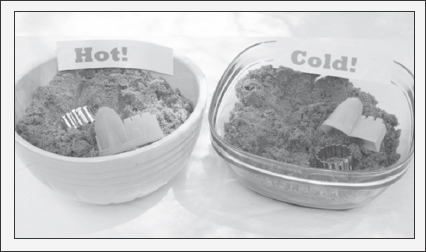
Sand is a good alternative for a child who is fearful of water.
Caution: If you use sand, take care that it is from a known source or is graded as “children’s play sand.” Cover and store the bowls and sand for future use.
Harder Activities:
• Play outside, bringing the child’s awareness to the temperature of things in the environment.
• Snow balls: On a snowy day, make snowballs, catch falling snow on tongues, drink hot chocolate, have the child put a hand on your neck to feel the warmth.
• Mud puddles (or garden hoses): On a hot day make a puddle (or fill a plastic bin) with a garden hose. Feel hot concrete, put bare feet in a puddle or bin, drink ice water.
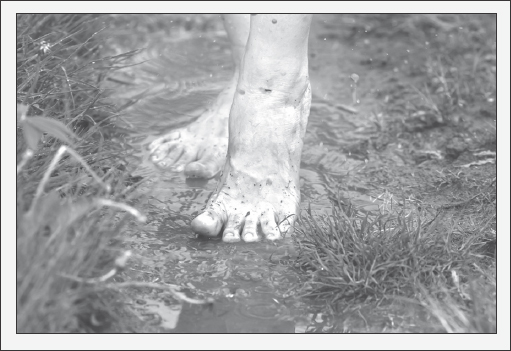
A cool mud puddle on a warm day is a perfect way to feel hot and cold at the same time.
• Stack hot and cold pennies. (See photo.) Set out two small bowls containing water— one with ice water, the other with hot, (but comfortable to the touch) water. Divide 30-40 pennies between the two bowls. (For children with poor fine motor skills, use larger coins like nickels or quarters.) Play one of the games listed below:
• Have the child stack pennies, alternating hot or cold pennies. Encourage the child to continue stacking until at last the stack tumbles.
• To further increase the challenge, have the child simultaneously get a hot and cold coin using two hands. Stack them.
• Switch bowl positions each time so that the child’s hands are alternately immersed in hot and cold water.
• Use a mixture of coins (pennies, nickels, dimes, and quarters) for a greater challenge in stacking
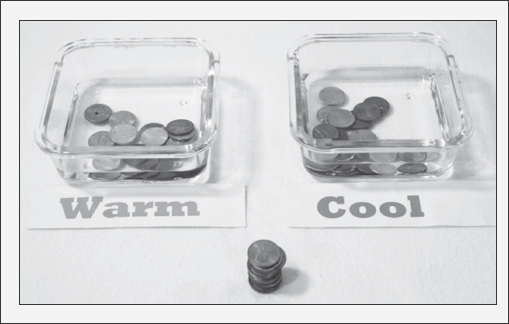
Coins are place in hot and cold water for the child to retrieve and place in a tall stack.
Caution: Small objects hazard.
• Make a racket with homemade drums and cymbals, and hot and cold spoons. Gather a variety of makeshift “drums and cymbals”: lids, jars (some partially filled with water), cans and an oatmeal box. Use hot and cold spoons as drum sticks. Now, make a racket! Replace the spoons with fresh ones when they lose their temperature. To dampen the noise, put pots and lids on towels. Use a simple social story like the one below to create a context for this type of play.
Story:“I’m happy! Let’s play “make a racket”! Here is a warm spoon, beat on the lid with the spoon. Now quick, get a cold spoon, beat on the pot with that. Yea! It’s fun to make a racket! Now let’s be quiet. Can you tap softly? . . .”
• Make a drawing with ice cold veggies and heated grains. Heat grains of rice, beans and lentils until they are very warm, place them in a dish labeled “hot.” Place small amounts of colorful frozen vegetable and berries into a bowl labeled “cold.” Lay out paper towels to draw on, and invite the child to draw a person, animal, house or car using the hot and cold materials. Coach him in making the picture by asking leading questions: “How many arms does he have?” “What color is the roof?” “Does your dog have ears? Where do they go?” Start the picture for him if he does not initiate himself.

Child draws a boy using frozen peas, corn, berries and warm beans and rice.
Enrichment 2
Play with Textures
Activity: Squeeze objects of different shapes and textures
Goals: To integrate touch, vision and motor; to increase fine motor skills.
Materials: Squeezable items, toys, food, and household items with different textures. Include hard items such as wood, stone and plastic; soft items such as fleece and yarn; mushy foods like bananas and berries; and squishy items such as a rubber duck or a Nerf™ ball.
Activities: Create simple games that allow the child to explore textures. Name the sensations and textures: soft, mushy, hard, cold, juicy, watery, silky or icky. Ask if she likes the way it feels.
• Wrap yarn or soft wire around a spool or small round container.
• Line up stones or marbles.
• Fill a squirt gun or rubber duck with water and squeeze.
• Squeeze fruits. (Have a bowl of rinsing water nearby so that the child can explore gooey textures and then clean up.)
• Wrap string around hand, arm or finger.
• In the kitchen, investigate foods and make a game of finding different textures – sponge, cloth, pan or spoon, plastic, vegetables.
• Stack wood blocks or logs.
• Investigate indoor or outdoor plants.
Safety considerations: Monitor the child when using yarn, string, wire and ribbon. Avoid a choking hazard by using large objects if the child puts things into her mouth.
Sensory considerations: If the child is unable to handle the texture of squeezing fruit, play a game in which she touches it quickly and then wipes it off her finger. See the desensitization section of chapter 1, and the section on touch desensitization in chapter 6.

Easier Activities:
• Press textured objects into the child’s hand and wrap her fingers around them. Say, “This is a [object name] it feels [soft, hard, mushy . . .].”
• Put an object on the table, with your hand over the child’s hand, help her pick it up, saying, “Pick up the [object name].”
• Put the object onto the table and tell her to pick it up. Once the object is in her hand, tell her to squeeze it.
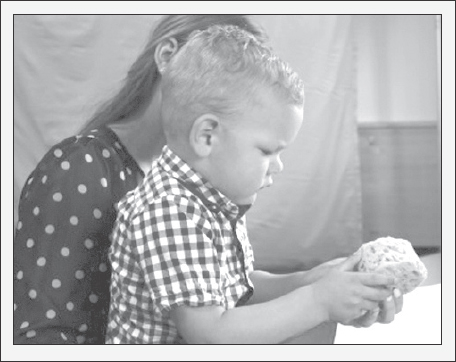
Harder Activities:
• There are many ways to investigate and enjoy textures including these:
• Make a yarn doll
• Make balls and snakes with dough
• Shoot marbles
• Make mountains in sandboxes
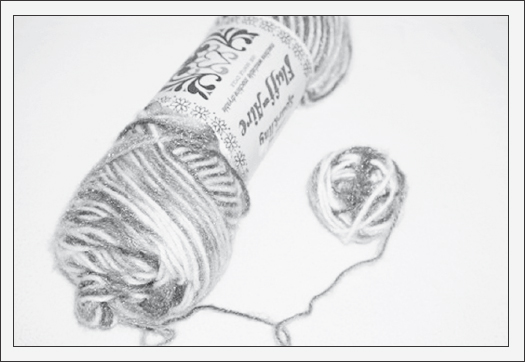
The texture of yarn is soothing. Have the child engage in activities such as rolling balls of yarn and making yarn dolls.
Enrichment 3
Sensation on Face and Arms
Activity: Draw imaginary lines on the child’s face and arms
Goals: To increase touch awareness; to desensitize to light touch; to register touch; to integrate touch and vision.
Materials: None needed.
Instructions: Tell the child that you are going to touch his arm with your finger. Draw lines on the child’s face, legs and arms. Vary the pressure of the touch. Start with a firm touch and eventually move to a feather-light touch. Talk about what you are drawing and how much pressure you are using. Later, ask him, “Is this a hard touch or a soft touch?” “How many lines did I draw?” “Is this a line or a circle?”
Safety considerations: Be aware that light touch can cause a defensive reaction in some children and cause them to react physically.
Sensory considerations: If the child is tactile defensive (acts with behaviors when touched), then consider first doing some strenuous play or aerobic exercise. Or have him hold and carry a heavy object like a weighted ball for about a minute. Use 1-2 pounds (.5-1 kilogram) weight for a toddler, up to 5 pounds (2 kilograms) for an 8-year-old and up to 10-12 pounds (4-6 kilograms) for older children.
In addition, try the easier activities listed below and make a note to share this information with the child’s team. Many sensory therapists are knowledgeable about therapeutic interventions for children with tactile defensiveness.
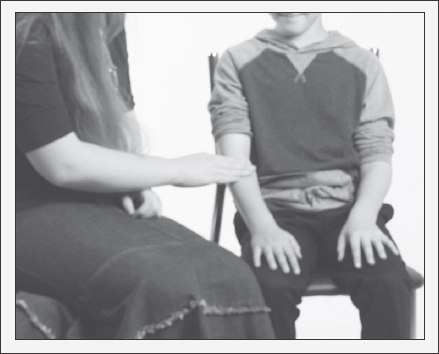
Adult firmly touches the child’s arm
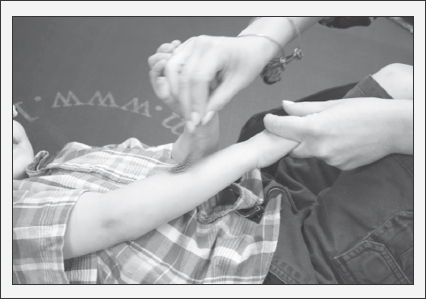
Adult draws a line on the child’s arm with a feather. Use the nib of the feather for a firm line. Use the feather hairs to give a light touch—as an advanced exercise.
Easier Activities:
• Massage the skin firmly prior to drawing on it.
• Lay your hand flat on the child’s arm firmly (or hold his arm firmly in your hand) for a few seconds then move your hand up and down on the arm, pressing firmly. Repeat on the other arm, and then on different areas of the face. This will help to decrease the irritation from the touch of materials.
• Here are ways to acclimate the child to touch, try these in the order given:
• Press your finger firmly on the child’s arm and leave it there for a few seconds.
• Press your finger on the skin and draw a short line with firm pressure.
• Use your finger to firmly draw lines on the child’s skin.
• Repeat the above steps on the face and legs.
Harder Activities:
• Draw lines with a lighter touch. If the child is defensive, rub out the spot you touched. Show him how to rub it out, too.
• Draw lines with a feather touch.
• Move to the activities in Enrichment 5.
Enrichment 4
Walk on Textures Blindfolded
Activity: Walk on a pathway of different textures blindfolded
Goals: To increase vestibular (balance) skills; to increase the sense-of-touch touch registration of novel materials; to integrate the touch and vestibular senses.
Materials: A scarf or sash for a blindfold; a walkway of textured surfaces. When working indoors include some combination of carpet, tile, wood, area rugs, shag carpet, fiber mats, rubber mats (see note), plastic mats, fake grass, thin bubble wrap and other textured materials. Lay them in a row on the floor near a wall that can be used for support. When working outdoors, incorporate grass, dirt, mud puddles and paved surfaces into the textured path.
Instructions: Create a path of textured materials near a wall. Place a blindfold on the child and have her walk on surfaces with different textures in bare feet. Have her use the wall for balance. If walking blindfolded proves to be too difficult, have her walk first without the blindfold. Once she is accustomed to this exercise, name the textures a second or two after she has stepped on them. Consider labeling each material: “wool, wood, tile, plastic,” and reciting the label names with her before and after the exercise.
Safety considerations: Ensure that mats are secure to the floor and do not pose a trip hazard to the child. Do Not Use Rubber Materials If The Child Has a Latex Allergy. Some children lose balance when they are blindfolded and so should try just a step or two at a time.
Sensory considerations: If wearing a blindfold is too difficult, ask her to close her eyes or cover her eyes with your hand. The easier exercises listed below should be helpful for children who do not tolerate bare feet. Children who crave bare feet will enjoy the harder exercises. However, if a child prefers bare feet because she does not tolerate the sensation of socks and shoes, you will need to eventually work on touch desensitization. This is covered in my previous book, Self-Regulation Interventions and Strategies.
Easier Activities:
• Keep shoes on to walk across the novel path, then walk the path in stocking feet.
• Try rubbing feet or pressing firmly on the sole and arches to decrease the irritation from light touch of materials like carpet.
• Take one step onto a new surface and stand there.
• Try to get the child to accidently step on the mat by standing on it yourself while holding a favorite object of hers. Ask her to come and get it. Don’t draw attention to the mat.
• Spread the mats around and make a game of jumping or hopping onto the surfaces.
• If the child appears fearful of a surface, place a favorite toy on it and let her retrieve it in her own time.
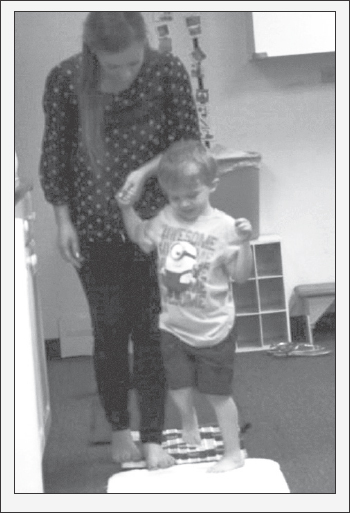
A boy is gingerly walking a textured pathway and holding the hand of an adult for balance.
• Try just one novel surface at a time and try easier ones first such as:
• Indoor-outdoor carpet
• Newspaper
• Bath mat, bath rug
• Plush carpet
• Vinyl, wood flooring
• Sand, soft dirt
• Playground mixture
• Try two or three surfaces at a time.
• Try each of the above in stocking feet then in bare feet.
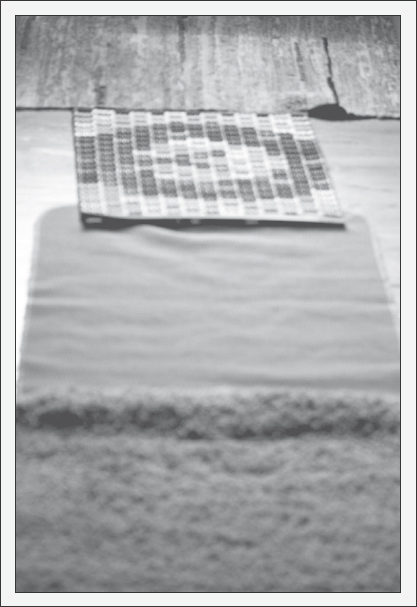
Here is a pathway made of a braided rug, a rough woven mat, a bathmat turned to the latex backing side, and a plush rug.
Harder Activities:
• Try each of these in bare feet:
• Cold tile, slate, marble
• Grass
• Cement (for a short distance)
• Polished stone porch or walkway
• Rough welcome mat
• Brick walk
• Increase the distance, for example, walk across a yard or play in a park with bare feet.
Enrichment 5
Sensation on Face and Arms with Music
Activity: Draw lines on the child’s face, arms, and legs with objects while listening to music
Goals: To increase touch awareness; to desensitize to light touch; to register touch; to integrate touch and vision; to integrate touch and hearing.
Materials: None
Instructions: Play quiet music in the background. Tell the child that you are going to touch his arm with your finger. Next, firmly draw a line on the child’s arm. Avoid soft touch until the child is comfortable with the exercise. Draw other lines on his arms, face and legs. Before you draw a line, tell him where you are going to draw it. Over time, make the touch lighter until it is a soft touch.
Safety considerations: None.
Sensory considerations: See Exercise 3. If a child is ticklish, put pressure on an area of the skin before drawing on it. Tell the child he can “rub it out” when you are done. A note on tickling: Honor the child who requests that you stop, while acknowledging his reaction, “Did that tickle? I’ll draw harder so that it doesn’t tickle you.”
Loud and unexpected noises and soft or unexpected touch can trigger the fight-flight system, and cause the child to respond with defensive (and possibly aggressive) behaviors. Listening therapy programs are available for purchase, which have shown to help reduce this reaction. In addition, Therapressure™, a “brushing” technique with level-2 evidence, has been shown to help some children. Informal exercises, like this enrichment, in which sound and touch are integrated, can help the child acclimate to sound and touch. Try both the easier and harder activities listed below, as well.
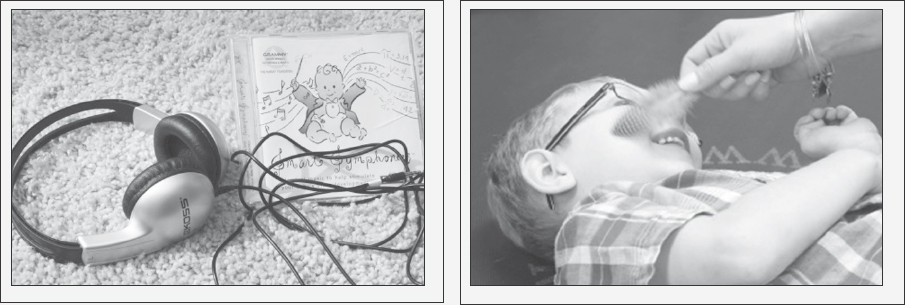
Easier Activities:
• See Enrichment 3 for easier touch activities.
• Play music softly in the background over speakers for a minute or two prior to introducing the drawing activity.
Harder Activities:
• See Enrichment 3 for harder touch activities.
• Try listening to music over headphones. (See the section titled Listening to music in the introduction to environmental enrichment.)
• Vary the type of music, avoiding music with a strong bass. (Or turn off the bass on the music device.)
• Attempt to draw lines on skin with soft objects. Stop if the child shows discomfort.
• Attempt to draw lines on skin with a light touch of the fingers. Stop if the child shows discomfort.
• If the child startles easily, talk about keeping his “ears turned on” so that he hears the warning signs of someone approaching. Use a story or the poem below to help make the point.
• Play with other children controlling bumping and noise until the child gets used to these factors. Gradually increase the intensity of play so that the child is exposed to the normal “rough and tumble” play of children.
Here’s a poem that can be recited in a singsong voice to help the child become more alert to auditory cues.
I Keep My Ears Open
I love to watch my cartoon shows
I love to play with my Legos
But when I do, I’m telling you
I keep my ears open! I keep my ears open!
When my ears are shut tight, sounds give me a fright
I don’t know who’s where, and suddenly I scare
When my ears are open wide, people sounds get inside
I hear you coming; I know you’re there
I love to watch my cartoon shows
I love to play with my Legos
But when I do, I’m telling you
I keep my ears open! I keep my ears open!
Enrichment 6
Match Object in Pillowcase
Activity: Find the twin of an object in a pillowcase
Goals: To help the child to recognize objects by touch only (increase stereognosis skills); integration of visual processing and touch processing.
Materials: A set of duplicate items small enough to put into a pillowcase such as keys, unsharpened pencils, spoons, buttons and small toys; labels for each object. Use items with different shapes, sizes and textures; optionally, an open bin filled with pom-pom balls to hide small objects in.
Instructions: Place one each of the duplicate objects into a pillow case. Show a twin object to the child and ask him to locate it in the pillowcase without looking. Display the object’s name on a small card as it is shown to the child to help with language comprehension skills. Ask the child to repeat the name of the object.
Safety considerations: Avoid using sharp objects.
Sensory considerations: Only gradually introduce objects or materials that the child finds noxious. For a child with low vision, place objects in an open bin containing filler such as small pom-pom balls. This is a good exercise for helping the child to recognize items in the environment.
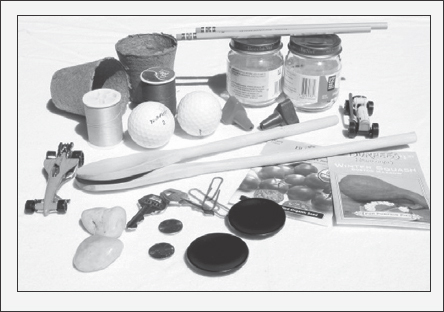
Use a wide variety of objects so that the child learns to identify different textures and shapes by touch.
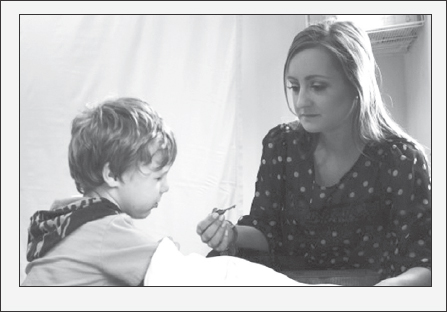
A boy tries to find a key among objects in a pillowcase.

For a child with low vision, hide everyday objects in bins of beads, pom-pom balls, popcorn, beans, torn rags, coins or shredded paper. This will help him learn to recognize items by touch in his natural environment.
Easier Activities:
• Explore the characteristics of items one by one. Is it warm or cold to the touch; hard or soft; bumpy or smooth; big or small?
• Put one object in a pillowcase and place its twin plus several other objects on the table. Ask the child to identify the item in the pillowcase.
• Repeat the previous exercise, but with 2-3 items in the pillowcase. Slowly increase the number of items in the bag.
Harder Activities:
• Use pairs of items that are slightly different such as two cars of different sizes or two different types of markers.
• Put the items into a bin filled with pom-pom balls or beans—as described in the materials section above. Name an item for the child to locate.
Enrichment 7
Scented Bath and Massage
Activity: Take a scented bath and a get a massage with scented oil or scented lotion
Once the child adapts to this exercise, it can be used as part of a bedtime calming routine.
Goals: To provide the soothing input of combined scent and touch; to integrate smell and touch.
Materials: Naturally scented bath salts, soaps and oils. Use child-friendly scents like fruits or flowers. You can make a batch of scented oil by putting a drop or two of essential oil into a small bottle of jojoba oil. Optionally, purchase natural scented oils and soaps, or purchase jojoba oil and bath salts, in health food stores and online.
For the alternate exercise, use a lightly scented lotion. If the lotion you have is too strongly scented, mix it with an unscented lotion to the desired intensity.
Alternate exercise: If the program is being done in a school environment, apply (or for older children, have the child apply) lightly scented lotion.
Instructions: Add a drop or two of essential oil to the child’s bath. Following the bath, give the child a massage with scented oil.
Safety considerations: Use only natural scents. To check for allergic reactions, put a dab of new oils or diluted salts on a small area of the child’s arm 24 hours prior to using it in the bath. Look for rashes, fevers or other indications of allergic reaction.
Sensory considerations: Ask the child which scents he prefers.
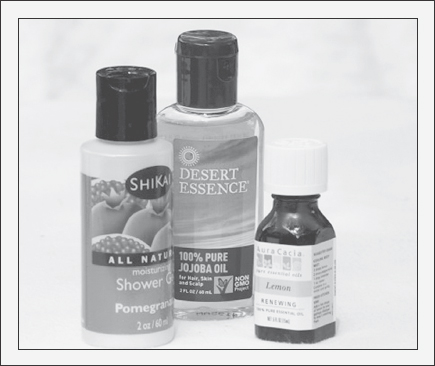
There are many natural options for bath scents. Consider making your own bath oil using grapeseed oil, sweet almond oil or jojoba oil with a few drops of the child’s favorite scent.
Bonus Activity: Make Bath Bombs
Bath bombs are a fun way to enjoy a fragrant bath. Hide a small toy in the bomb and see the surprise on the child’s face when it appears in the fizzing water! Hot water (not cold water) activates the bombs. A small child can help in making the bombs if you first wrap sandwich bags around his hands before he “mushes” the mixture and forms the bombs.
Ingredients:
1 1/2 cup baking soda
1/2 cup citric acid powder (available online and where canning supplies are sold)
Grapeseed oil or Sweet almond oil
Essential oil(s) for scent
Small toys
Optional: food coloring
Optional: craft molds (available at craft stores)
Mix the dry ingredients.
(You can make a large batch of the dry ingredients and store what you don’t use in a tight container.)
1. Put a sieve over a bowl. Put the baking soda and citric acid through the sieve.
2. Mix well with a whisk.
Make the bombs:
1. In a small bowl, add ½ tsp. of grapeseed oil or sweet almond oil, 4-6 drops of essential oil and (if you are using it) about 10 drops of food coloring.
2. Add ½ cup of the baking soda and citric acid mixture and mix well using your fingers to ensure that it is mixed well. (Use gloves if you are using food coloring.)
3. Place a small toy in the center of the mixture and firmly press the mixture in the bowl flat. Optionally, place the toy and mixture into a craft mold.
4. Gently slip the bomb out of the bowl and upside down onto a flat container. It will be dome shaped. If you are using a mold, remove the bomb from the mold.
5. Continue making bombs until your batch is used up. Store the bombs for 36 hours before using.
Enrichment 8
Attention to Sound and Temperature
Activity: While speaking or singing, touch arms and legs with a cooled or warmed spoon
Goals: To acclimate to being touched by objects in the environment; to decrease fight-flight reaction from random touch; to integrate touch and sound.
Materials: Two spoons and a source for heating and cooling the spoons such as cups containing hot and ice cold water.
Instructions: Pour hot water into one cup and cold water into another. Place spoons into them and let them sit for a minute or so. Check the spoon’s temperature then place one spoon on the child’s leg or arm while talking or singing to the child. Put that spoon back into its cup and switch spoons. Continue doing this for several minutes.
Safety considerations: Take care with the water temperature. As mentioned, be aware that light touch can cause a defensive reaction in some children and cause them to physically react.
Sensory considerations: If the child has tactile defensiveness, start each session by pressing the spoons firmly to the skin prior to lightening the touch. Also read the sensory considerations sections in Enrichments 3 and 5.
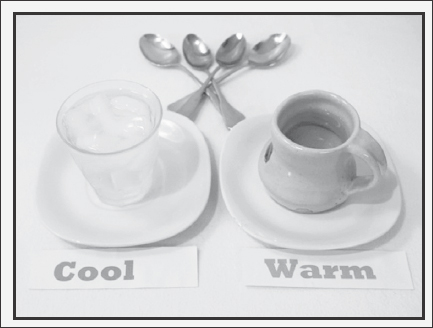
Ice water and hot water for chilling and warming the spoons.
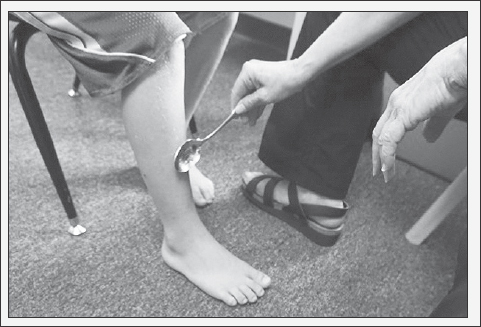
Adult placing spoon on child’s leg while speaking to the child.
Easier Activities:
• See the easier activities for Enrichment 5 for sound and touch.
Harder Activities:
• See the harder activities for Enrichment 5 for sound and touch.
• In a group setting, sit in a circle and pass a cool object, then a warm object from child to child. Repeat this with a warm sandbag, potato or stone.
• Play toss with a chilled orange or apple. For younger children, roll an orange or apple on the floor back and forth.
Enrichment 9
Body Sensation and Temperature
Activity: Draw lines on arms and legs with cooled or warmed spoons
Goals: To help the child to acclimate to temperature and to objects touching her; to help with touch discrimination as the line is drawn.
Materials: Two spoons and a source for heating and cooling the spoons such as cups containing very hot and very cold water.
Instructions: Pour hot water into a cup and place a spoon into it. Pour ice water into another cup and put the other spoon into it. Let them sit for a minute or so. Check the spoon’s temperature, then when the temperature is right, draw lines on the child’s skin. As in Enrichment 5, vary the pressure of the touch. Start with a firm touch and eventually move to a feather-light touch. Put the spoon back into its cup and switch spoons. Continue doing this for several minutes.
Safety considerations: Take care with the hot water and keep it out of a young child’s reach. Again, remember that light touch can create a defensive reaction in some children and cause them to physically react.
Sensory considerations: If the child has tactile defensiveness, be sure to press the spoons firmly onto the skin.
Easier Activities:
• See Enrichments 1 and 8 for easier hot and cold activities.
• See Enrichment 3 for easier touch activities.
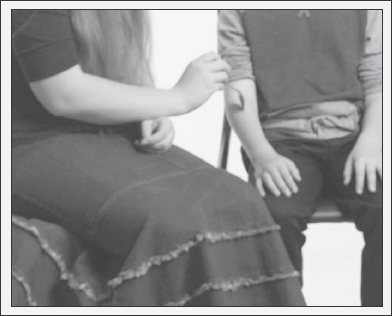
Adult drawing line on child’s arm with a spoon.
Harder Activities:
• See Enrichments 1 and 8 for harder hot and cold activities.
• See Enrichments 3 and 5 for harder touch activities.
• For overall temperature tolerance, have the child help with functional activities such as:
• Passing small warm or cool bowls of food at the dinner table
• Carrying wet towels from the bathroom
• Carrying clothes fresh from the dryer
• Helping to get fruit from a bin in the refrigerator
• Make a walking version of tag called “apple tag” in which children tag with a chilled object such as a small apple.
Enrichment 10
Visual Matching Pictures & Objects
Activity: Match a picture of an object to the real object
Goals: To increase object identification skills, attention skills; visual discrimination; integrate vision and motor.
Materials: A collection of objects plus pictures of them. For example, if you are using a book with pictures of fruit, you will need a set of matching real or plastic fruit. Optionally, create a collection of objects and take photos of them. You may want to print the photos (as opposed to showing them on a phone or tablet) to decrease the chance of the child being distracted by electronics.
Instructions: Put a collection of objects near the child. Ask him to look at a picture of one of the objects and point to the actual object. If this task is too easy for him, consider finding objects that have a similar appearance so that he must match subtler features of the objects. Ask him to name the objects.
Safety considerations: Avoid very small objects with a child who is young or puts things in his mouth.
Sensory considerations: None.
Easier Activities:
• Use photos (which are easy for a concrete thinker) instead of images.
• Start with photos of yourself and of the child. Show a picture of him and ask him to point to who it is. Next show him a picture of you.
• Limit to two or three objects on the table for him to choose from.

Harder Activities:
• Line up pictures of objects on a table, and then have the child place each object on top of its photo.
• Instead of using a picture, use oral commands. Say the name of one of the objects and ask the child to point to it.
• See Enrichment 17.
Enrichment 11
Walk a Plank
Activity: Walk on a 2 × 8-inch × 5-foot plank with eyes open, then blindfolded
A child’s ability to balance while walking on a plank may change dramatically with a blindfold. Some children lose balance when they are blindfolded, while others can walk blindfolded but are unable to do as well without the blindfold. In either case, practice is typically all that is needed to increase skills.
Goals: To increase vestibular (balance) skills; to improve attention and focus skills; to integrate vision and vestibular senses.
Materials: A board approximately two inches (5 centimeters) thick, eight inches (20 centimeters) wide and about five feet (1.5 meters) long. A four-inch-wide (10 centimeter) board may work and will be a greater challenge for an older child. Boards longer than five feet can be used, but may be more difficult to store.
Instructions: Place a wooden plank on the floor near a wall for support. Ask the child to walk the length of the plank. Blindfold her, and then ask her to walk it again. (This exercise begs for stories of pirates walking the plank – but only after the child has achieved success. See poem at the end of this exercise.)
Safety considerations: The board should not be more than two inches thick so that children who are unsteady will not hurt themselves if they lose balance.
Sensory considerations: If this is too difficult for the child, start with walking between two lines on the floor. Make the lines closer and closer together until the child can manage a width of eight inches. Next, move to a one-inch thick board and finally to the two-inch board. (See the easier instructions.)
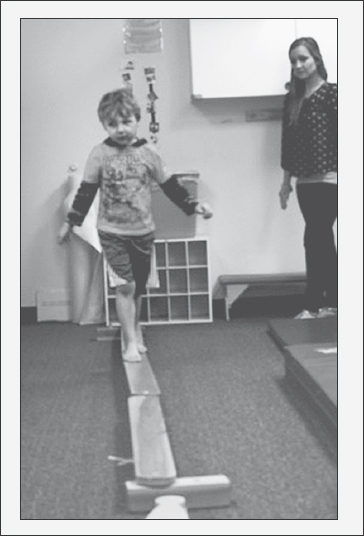
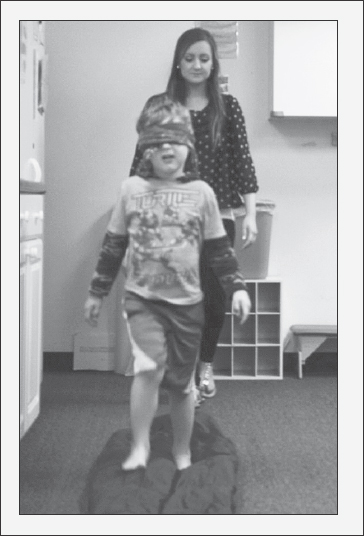
Easier Activities:
For some children, this activity may be quite difficult. In this section, the process has been broken down into small, easier steps.
• Walk a line:
• Place a circle or ‘x’ on the floor (near a wall) with masking tape or string and ask the child to stand on it. A circle will be conceptually easier for the child.
• Draw a line on the floor, six-feet long. Place an ‘x’ or a circle at each end. Ask the child to walk on the line from one ‘x’ to the other. Hold her hand and steady her, if necessary.
• To increase acceptance of the blindfold:
• Put a blindfold over your eyes and laugh. Then tell the child it’s her turn.
• Use a treat or social reward such as a hug to help her accept the blindfold.
• Place your hand over her eyes.
• Use a paper bag instead of a blindfold.
• Walk the line blindfolded:
• Demonstrate walking the line with the blindfold over your eyes. Ask the child to hold your hand as you do it.
• Place the blindfold on the child and hold her hand as she walks on the line.
• Getting used to the board and the blindfold:
• Place the board on the floor near a wall. Have the child stand on the board.
• Have the child walk the length of the board.
• Have the child stand on the board blindfolded.
• Hold the child’s hand, and then have her walk the length of the board with the blindfolded.
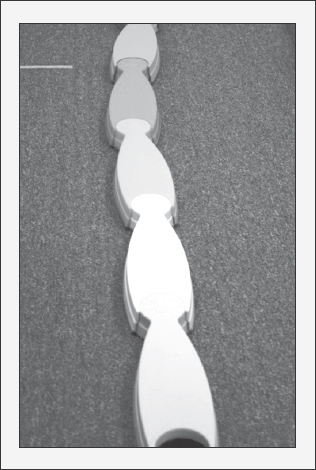
Two inch (5cm) high blocks that can be assembled for a walking path
Harder Activities:
• Carry an object while walking a line. A long object such as a yardstick (or meterstick) will help with balance.
• Carry a smaller object while walking the board.
• Carry a smaller object while walking the board blindfolded.
• Enrichment 16.
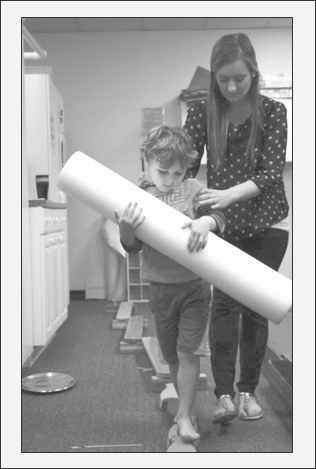
Child carrying a large object while walking on a board
I WALK THE PLANK
My eyes, they are blind
Still I walk a straight line,
With body straight and tall
And steps very small
My arms are stretched wide
And sway side-to-side
And so I don’t fall,
I can touch the wall
I walk the plank true
I walk it fast, too
No pirate at sea
Walks it better than me
Enrichment 12
Pick Beads from Ice
Activity: Remove a colored bead from a dish filled with ice cubes
Goals: To improve visual discrimination, fine motor skills, and touch or thermal sensory integration.
Materials: 8-12 ice cubes; one or more colored beads; a flat dish. Grade the skill level needed for this exercise by increasing or decreasing the size of the beads.
Instructions: Put ice and one colorful bead on a flat dish. Have the child pick the bead from the dish. When the child is successful at performing this exercise, consider placing several beads on the plate.
Safety considerations: If the child has poor temperature sensation, be sure that he does not hold onto ice cubes for more than a few seconds.
Sensory considerations: If you suspect the child is color blind, use a bright or dark colored bead.
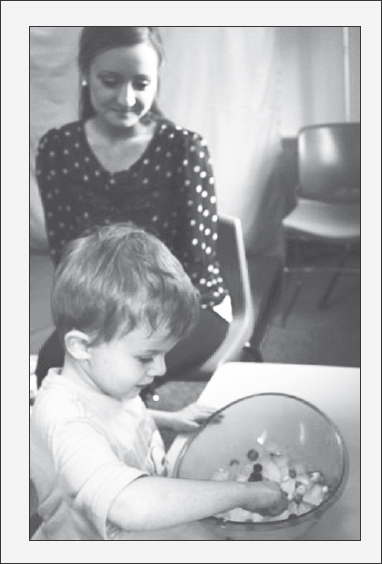
Child picking beads from a bowl of ice
Easier Activities:
• If the ice causes problems, use clear beads or tempered-glass stones in place of the ice.
• Pick a red bead out of a bowl of yellow or white beads.
• Put beads in a dish with a small amount of chilled water. Have the child pick them out of the dish.
• Enrichments 8, 9, 18.
Harder Activities:
• Enrichment 22.
Enrichment 13
Attention to Sound
Activity: Use a sound cue to distract attention away from a visual task
Goals: To increase attention to sound cues and to speaking.
Materials: Photos or a book of pictures; a bell, buzzer or small gong.
Instructions: Show the child a picture, then ring a bell and say her name or a phrase such as, “look at me.”
Safety considerations: None.
Sensory considerations: Choose a bell or sound that is not annoying to the child.

Bells for cueing
Easier Activities:
• While the child looks at the picture, ring the bell and gently touch her hand or her face while saying, “Look at me.” Optionally use a reward to reinforce this.
• Create a small story such as the following and read it to the child: “I like to look at books. But I also need to pay attention to the sounds around me. When I hear a bell or hear [mom, my teacher, Miss Rita] call my name, I need to look at [mom, my teacher, Miss Rita] and see what she wants.”
• Read the poem in Enrichment 5, “I Keep My Ears Open.”
Harder Activities:
• Get the child’s attention by saying her name without ringing the bell.
• Get the child’s attention by ringing the bell without saying her name.
• If the child is annoyed by a bell or buzzer sound, record the sound and play it in the background at a reduced (and comfortable) volume several times a day. Slowly turn up the volume.
Enrichment 14
Find Objects in Water
Activity: Remove objects from cool and warm bowls of water
Goals: To increase fine motor skills; improve thermal and touch integration.
Materials: Two bowls; small objects such as marbles, keys, or coins.
Instructions: Fill one bowl with warm (not hot) water, the other with cool water. Place small objects in each bowl. Have the child pick objects from bowls in succession. Replace the objects and repeat for several minutes.
Safety considerations: Ensure that water temperature is not too hot or cold. Small objects are a choking hazard.
Sensory considerations: None.
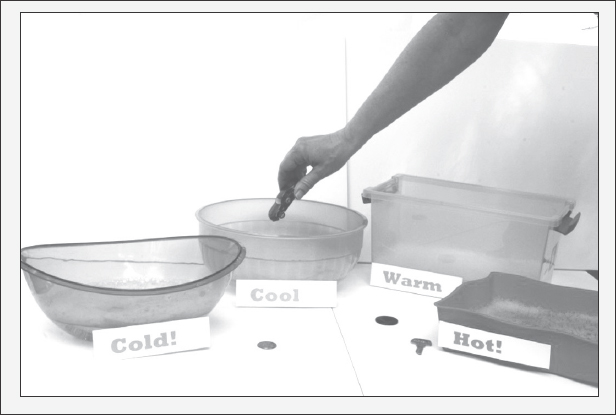
Put various objects in different water temperatures and have the child retrieve them.
Easier Activities:
• Enrichment 1.
• Use larger, easier-to-grasp objects.
Harder Activities:
• See the harder activities in Enrichment 1.
• Put small grains of rice or beans in the water.
Game: Find the coin
Materials: Cups, dish soap, coins
Instructions: Put water of different temperatures into small bowls. Add enough dish soap to make thick bubbles. Have the child swish the water to make bubbles in each bowl, and then hide a coin or “prize” in one of the bowls. Have the child look for the coin in each bowl.
Enrichment 15
Pull a Button from Fingers
Activity: Pull a button from between someone’s fingers
Goals: To increase fine motor skills; to increase sensation of finger pressure.
Materials: Buttons of different sizes and colors.
Instructions: Start with a large, bright or dark colored button. Hold the button between your fingers. Tell the child to take it from you. Repeat this exercise using smaller and smaller buttons. Also, gradually use buttons of a lighter color. Once she is familiar with this procedure, have her put the button into a piggy bank or slotted jar.
Safety considerations: There is a small object hazard for children who put things in their mouths.
Sensory considerations: None.
Easier Activities:
• Pick up small objects.
• Enrichment 12: pick bead out of ice.
• Enrichment 14: remove objects from water.
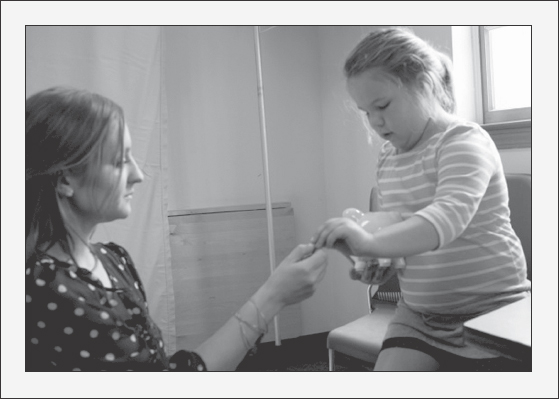
Pulling a button from an adult’s hand.
Harder Activities:
• Button a large button.
• Zip a jacket.
• Button a small button through a loose hole.
• Button a small button through a tighter hole.
• Enrichment 25: put coins in a piggy bank using only a mirrored reflection of hands.
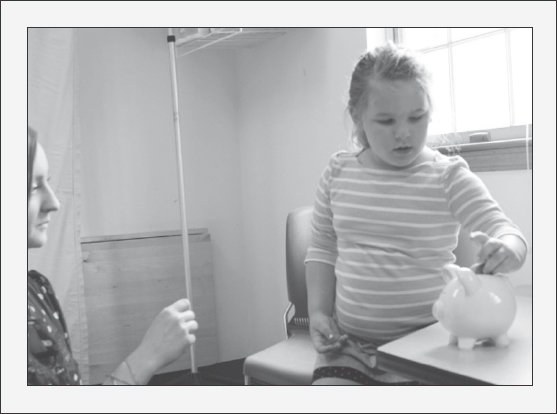
Girl takes a coin from the therapist and puts it into a piggy bank.
Enrichment 16
Walk on Bouncy Surface
Activity: Walk on a bouncy surface of foam or large pillows with eyes open, then blindfolded
Goals: To increase the ability to balance; improve attention-to-task.
Materials: Enough thick foam or pillows to make a three-to-five foot-long (1-1.5 meter) path. The foam should be about as thick as a pillow.
Instructions: Place foam, large pillows or a doubled-over sleeping bag on the floor near a wall for support. Have the child walk on them. When he can do this successfully, blindfold him and ask him to walk on them again.
Safety considerations: The foam or pillows should be challenging but feasible to walk on. Make sure the child moves slowly as he walks. Some children lose balance when they are blindfolded, and so they should try just a step or two at a time.
Sensory considerations: See Enrichment 11 for a discussion and strategies for balance (vestibular) issues.
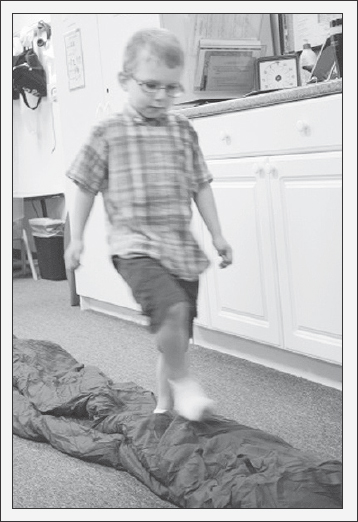
Boy walks along a rolled-up sleeping bag.
Easier Activities:
• Enrichments 4, 11.
Harder Activities:
• Walk across piles of blankets and towels.
• Walk across a large pillow made of large chunks of foam.
• Walk across an air mattress placed near a wall. Use wall for support.
Enrichment 17
Name Objects in Pictures
Activity: Point to objects in a picture and name them
Goals: To integrate motor and speech; increase cognition.
Materials: Books with pictures of objects.
Instructions: Have the child look at a page of pictures of objects. Then ask him to point out and name objects that he sees.
Safety considerations: None.
Sensory considerations: None.
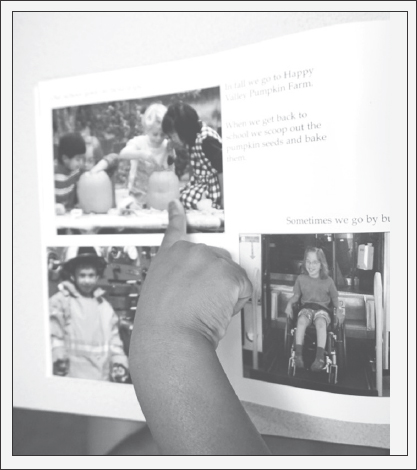
Girl points to a pumpkin in a picture.
Easier Activities:
• Enrichment 10: Match an object to its picture.
• Point to familiar objects on verbal command.
Harder Activities:
• Point to a line drawing of an object in a picture.
• Describe color, size or other features of the object.
Enrichment 18
More Attention to Temperature
Activity: Place a finger on a cool object, and then on a warm one
Goals: To increase thermal awareness and thermal discrimination; touch and thermal integration. This exercise can also be used as part of a safety lesson (with a story or video) for hot and cold.
Materials: Warm and cool objects. At home, these could consist of food fresh from the refrigerator or the microwave. In hot or cold weather heat or air vents and cold or warm windows work. For older children, the refrigerator itself or a warm stove suffice.
Instructions: Place the child’s fingers on a cool object, and then on a warm object. Say the words “warm” and “cool” as the child’s finger moves.
Safety considerations: Check an object’s temperatures prior to having the child touch its surface.
Sensory considerations: Some children with autism process both pain and temperature slowly. The child may feel the heat or cold sensation only after several seconds have elapsed. Use objects that are hot and cold—but not so hot as to be unsafe—as they will register more easily. Exercises such as these can help to increase awareness and to decrease processing time.
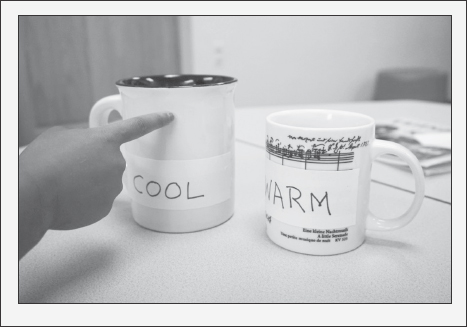
Touch a cool object then a warm one!
Easier Activities:
• See Enrichments 8 and 9.
Harder Activities:
• At home, ask the child to help in the kitchen and touch cold, cool, warm and almost hot ingredients and foods.
• Write a story together or have a conversation about how cold things get warmer and hot things become cooler.
I Can Feel So Much!
Is it cold? Is it hot?
Is it warm? Is it not?
Is it cool to my touch?
I can feel so much!
When it’s hot or very cold,
Stay away, I am told
Like the oven and the fire
And the freezer and the dryer
Like the pot and the pan
Or the backside of the fan
They can hurt me! I should learn
What is safe and what will burn
What is cold? What is hot?
What is safe? What is not?
Is it cool to my touch?
I can feel so very much!
Enrichment 19
Pick Up Rice
Activity: Create a small depression in dough and put rice into it
Goals: To increase fine motor skills and visual motor skills; integration of touch, vision and motor.
Materials: Dough or Play-Doh™; grains of rice, or small beans, peas or lentils. Recipes for dough are provided in the touch desensitization section of Chapter 6.
Instructions: Place a chunk of dough on a table. Have the child press a hole in it and then place grains of rice into the hole. If rice grains are too small for the child to manipulate, try using small beans, peas or lentils instead.
Safety considerations: Use edible dough if the child mouths objects.
Sensory considerations: If the texture of the dough is too gooey for the child, then put the rice grains into a bottle cap instead.
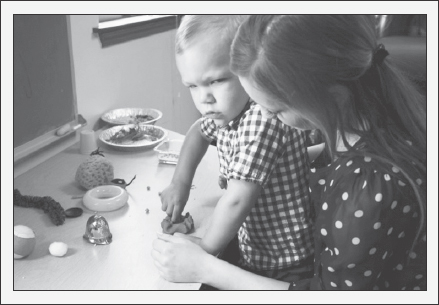
Roll the dough into a ball, then press the center to make a bowl.
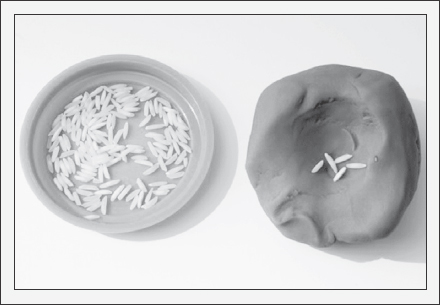
Place grains of rice into the bowl.
Easier Activities:
• Play with dough.
• Press dough into shapes.
Harder Activities:
• Create dough people or animals with rice and beans for eyes, mouth and nose.
• Create dough people or animals and make eyes, ears, nose and mouth from small pieces of different colored dough.
Enrichment 20
More Visual Matching
Activity: Select a textured square that matches its photo
Goals: To increase visual discrimination skills; integration of touch and vision.
Materials: A collection of 2x2 inch (5x5 centimeter) squares of different textures; photos of the squares. Squares can be cut from plastic mats, carpet, cardboard, bubble wrap, foam, aluminum foil, fine sandpaper, felt and sponge.
Instructions: Place the textured squares on the table. Show the child a photo of one of the squares and have her pick out and pick up the matching square.
Safety considerations: Avoid rubber if the child has a latex allergy.
Sensory considerations: Be aware of textures that the child does not wish to touch. Gradually expose the child to that texture.
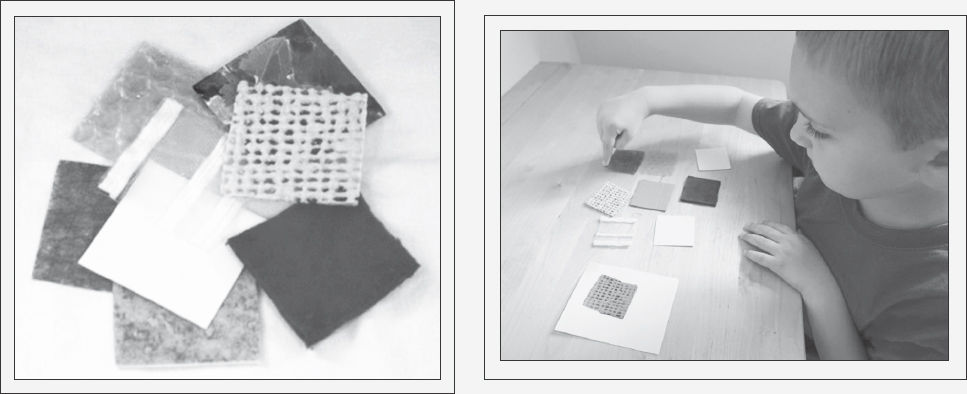
Cut two-inch square tiles of differently textured materials. Ask the child to match a photos of the tiles to the actual tiles.
Easier Activities:
• Enrichment 2 and the harder activities listed there.
Harder Activities:
• Have the child say, write, type or point to a word that describes a texture such as fuzzy, scratchy, soft, hard, cool, and so on.
• Have the child name the color.
• Have the child identify what the texture is used for, such as, “That’s carpet.” Or “That’s for curtains.”
Enrichment 21
Sensation of Textures on Face
Activity: Draw imaginary circles on the child’s face using textured objects
Goals: To increase sensory awareness of the skin; to increase cognitive awareness of textures.
Materials: Objects of different textures including small toys.
Instructions: Take turns using textured objects, including toys, foods and household items, to draw circles on the face of the child. Once he is comfortable with the process, ask him questions such as how big the circles are, whether they feel soft, hard or mushy, and what feels best.
Safety considerations: Keep an eye out for sharp surfaces on objects.
Sensory considerations: If the child displays defensiveness to touch, use a firm rather than a light stroke.

The paw of a small fuzzy toy animal works well for this exercise.
Easier Activities:
• Enrichments 3, 5.
Harder Activities:
• See the suggestions for harder activities in Enrichments 3 and 5.
• Ask the child to close his eyes and guess what you are using for drawing.
Enrichment 22
Play with Cold Objects
Activity: Places ice-filled straws into dough, alternating hands
Goals: To increase thermal sensory awareness; decrease thermal sensitivity; integrate touch, thermal and visual senses.
Materials: A chunk of dough or Play-Doh™; ice straws or straws filled with water and frozen. To fill straws with ice, cap one end with wax, dough or gum. Fill straw with water, and then set it upright in the freezer until the ice has frozen, or use a kitchen gadget called an ice straw maker to make ice straws. (It’s found in kitchen shops and online). Optionally, freeze long green beans.
Instructions: Place a chunk of dough on the table. Have the child press ice-filled straws into the dough, alternating hands or using both hands as she does this. If the child is using ice cubes, have her pick them up using a single layer of thin cotton or waxed paper to reduce the chill.
Safety considerations: Limit the child’s exposure to ice straws to a few seconds at a time.
Sensory considerations: If this is too challenging, have the child use an additional layer of cotton when picking up the ice filled straws or ice straws.
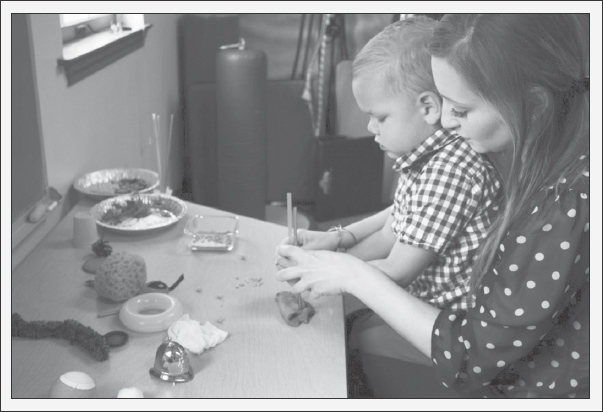
Straws were filled with water, sealed with wax and put in the freezer for an hour prior to this exercise.
Easier Activities:
• Instead of ice straws, push unsharpened pencils into dough.
• Wrap ice cubes inside a thin dish towel and have the child hold them for a few seconds.
• Hold ice straws in the hand for five seconds.
Harder Activities:
• Take an ice cube from a tray and put it into a glass of water.
• Have the child bury seeds or stones deep and firmly into a pot of soil or in an outside garden area.
Enrichment 23
Walking a Plank - Plus
Activity: Walk on a 2 × 8-inch × 5-foot plank while carrying a chilled tray
Goals: To increase the ability to balance; improve attention and focus skills; integrate vision and motor.
Materials: A metal or plastic tray placed in the refrigerator; a board approximately two inches (5 centimeters) thick, eight inches (20 centimeters) wide, and minimally five feet (1.5 meters) long.
Instructions: Place the wooden plank on the floor near a wall so that the child can use it for support. Give the child a cooled tray and ask him to hold it as he walks back and forth on the plank.
Safety considerations: Touch the tray to ensure that it is not overly cold. To avoid a twisted ankle during a fall, the board should not be more than 2˝ thick.
Sensory considerations: If the child has balance (vestibular) problems, remind her to lean on the wall for support, as needed.
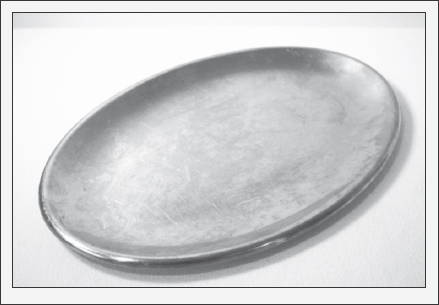
Carry tray while walking on the plank.
Easier Activities:
• Enrichments 4 and 11.
Harder Activities:
• Use a four-inch-wide (10 centimeter) board as a greater challenge for an older child.
Enrichment 24
Visual Attention to Massage
Activity: Rub fingers and toes in turn, while the child watches
Goals: To integrate visual and tactile senses; to increase touch sensory awareness.
Materials: None.
Instructions: Rub each of the child’s fingers and toes as she looks on. Do this slowly over a 3-minute period.
Safety considerations: None.
Sensory considerations: None.
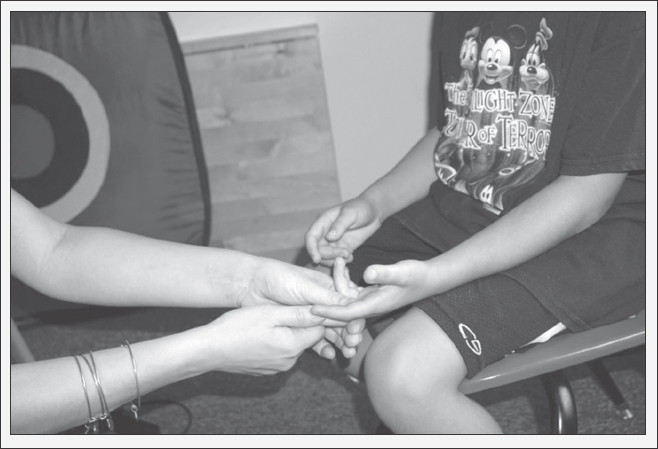
Therapist is giving a boy a finger massage.
Enrichment 25
Coins in a Piggy Bank with Mirror
Activity: Place coins in a piggy bank using only a mirrored reflection of hands
Goals: To increase visual motor skills and cognitive strategies.
Materials: Piggy bank, coins, small-medium sized mirror; folder, cardboard box or other item that can be used to occlude the child’s sight of his hands as he sits at the table and puts coins in the piggy bank. (See photo and construction details, below.)
Instructions: Place a piggy bank and coins on a table. Place a standing mirror (or prop up a hand-held mirror) at the back of the table. Occlude the child’s sight of the piggy bank by placing a folder or box at the front of the table. Have him sit at the table and put coins in the bank using only the reflection in the mirror of his hand, the bank and the coins.
Safety considerations: Make sure the mirror is secure. Sensory considerations: None.
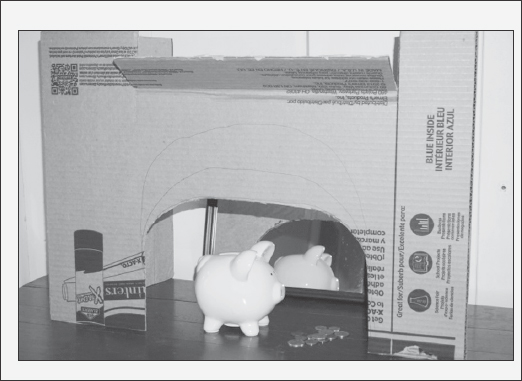
The setup for this exercise can be constructed using a 3-fold science project display board and a small mirror.
Easier Activities:
• Try some of the harder activities in Enrichment 15.
• Put an empty container and several objects on the table. Blindfold the child and ask her to find the objects and put them in the container.
• Put figurines and small cars on a table on their sides. Blindfold the child and ask her to set them upright.
• Have her comb hair in the mirror.
Harder Activities:
• Zip a jacket without looking at the hands.
• Button without looking at the hands.
• Button a shirt button while looking in the mirror.
Enrichment 26
Magnetic Fishing Pole
Activity: Pick up small objects using a thin pole with a magnet attached
Goals: Increased visual motor skills.
Materials: Toy fishing rod with a magnet at the end, or a home-made fishing rod constructed using a pen or ruler, string and a magnet; ten or more colorful metal paper clips or other small metal objects.
Instructions: Scatter paper clips on the table. Give the child the “fishing” rod and ask him to use it to pick up the paper clips.
Safety considerations: Do not put the magnet near electronic equipment or credit cards.
Sensory considerations: None.
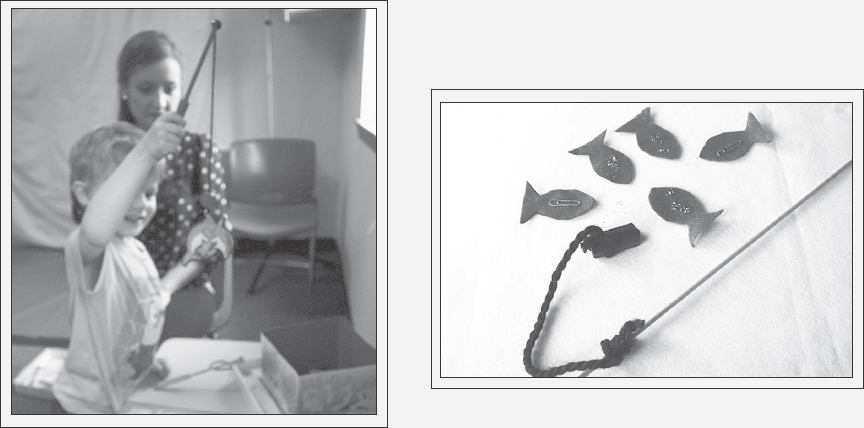
Games with magnetic fishing rods can be found in stores and online. However, you can make one using household materials and a small magnet.
Easier Activities:
• Give the child a ruler or small rod and ask him to use it to touch objects in the environment. The goal is to learn how to extend his reach using another object.
Harder Activities:
• Put small objects under a chair or dresser and ask the child to extract them (“fish them out”) using a ruler.
• Put a shoe far under a bed and ask the child to recover it using a rod or a broom.
Enrichment 27
Visual Tracking
Activity: Track a red object as it moves around a picture
Goals: To increase visual tracking skills; to improve attention to task.
Materials: Pictures of well-known paintings. Find collections of pictures in used-book stores, the internet (search on “classical paintings for children”), or take photos at a museum.
Instructions: Put the picture on the table and let the child look at it for a few moments. Next, put the red object next to the photo and tell him, “Look at the red ____.” Move the object slowly around the picture, telling him, “Keep looking.”
Safety considerations: None.
Sensory considerations: If the child is colorblind, be sure to use a bright, preferably red, object.
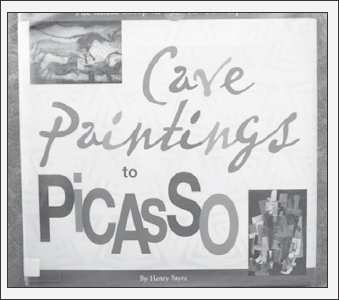
Books like Cave Paintings to Picasso by H. Sayre, are a good source of child-appropriate artwork through the ages.
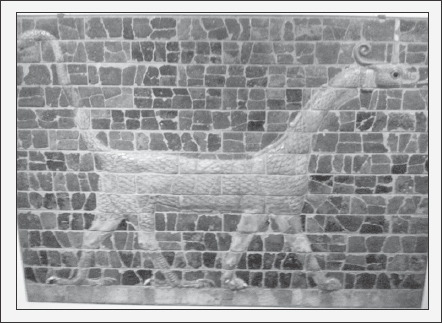
Photo of Mosaic: Marduk, god of Baal, Detroit Institute of Arts.
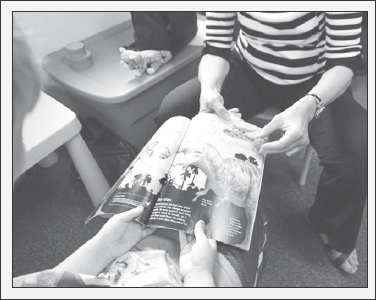
Therapist holds a large red bead and moves it around a picture of a dinosaur while the child tries to keep her eyes on the red bead.
Easier Activities:
• In a darkened room, use a flashlight to create clockwise and counter-clockwise circles on the wall. Ask the child to keep head still and her eye on the flashlight beam. Make the circles small enough for her to look at without moving her head.
• With a flashlight, slowly trace a large circle on the wall and ask the child to move her eyes, following the path of the light.
Harder Activities:
• Use a favorite picture for the background image (dinosaurs, trains, or cartoon characters) to increase the challenge for paying attention to task.
• Put an eye chart just above eye-level on a wall near a trampoline. As the child jumps, ask her to read a row or column of letters. You can make an eye chart on a large sheet of paper by neatly printing rows of numbers and letters in marker. Make sure the columns line up.
Enrichment 28
Navigating Stairway Without Hands
Activity: Walk up and down stairs while holding a big ball or pillow
Goals: To improve balance, attention and coordination; to integrate the vestibular and touch senses.
Materials: A big ball or a pillow; stairway.
Instructions: Give the child the ball or pillow and ask her to walk up and down the stairs.
Safety considerations: An adult should stay on the steps just below the child as she walks, in case she loses balance or slips.
Sensory considerations: Some children are afraid of steps due to poor vestibular function. Make a set of short steps using reams of paper, bricks or sturdy blocks. Have the child master this, then gradually increase the step height. For persistent problems, occupational therapy or physical therapy is recommended.
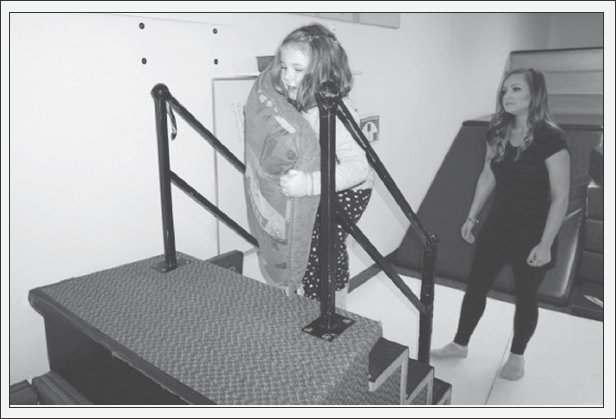
Child carries a bolster up a short staircase.
Easier Activities:
• Have the child carry a succession of soft objects up and down stairs while holding the rail. Start with small objects, and then move to bulkier items.
• Have the child walk up and down stairs without holding the rail and with nothing in his hands.
Harder Activities:
• Continue this activity with larger and heavier items. Have an older child carry a laundry basket, book bag or stack of games up and down stairs.
Enrichment 29
Draw What You Feel
Activity: Draw shapes using pencil and paper to match shapes being drawn on the child’s back (over shirt)
Goals: To increase visual-motor skills; to integrate touch, vision and motor; to learn to ignore distracting and conflicting sensory input.
Materials: Paper and pencil or fat crayon; one or more toys that can be used to draw with.
Instructions: Put a pen and paper on the table. Have the child draw a shape. As she does, draw the same shape on her back using your finger. Switch up. Draw a shape on the child’s back and have her copy what she senses onto paper. Continue taking turns.
Safety considerations: If the child mouths objects, be sure to use non-toxic drawing materials.
Sensory considerations: If the child is tactile defensive (dislikes being touched), the adult should press firmly while drawing. Also consider providing calming input to the child such as a back massage or shoulder squeezes before drawing on her back. Also, see the sensory consideration section of Enrichment 1 for additional ideas.
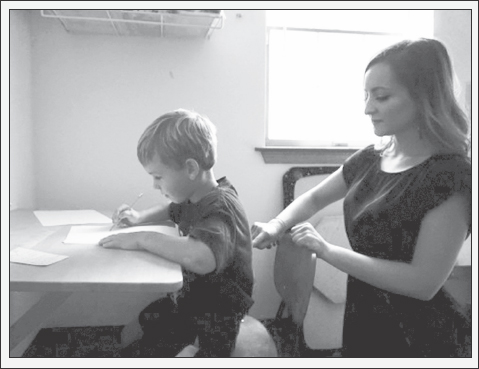
The therapist draws shapes on the child’s back while he senses the shape and then draws it.
Easier Activities:
• Teach the child to draw lines and shapes.
• Draw only lines, circles or dots on the child’s back and ask him to guess what you have drawn.
• Add new shapes, one at a time, until the child is proficient at registering and then drawing them.
Harder Activities:
• Tell her to draw a shape like a triangle, circle, or square on paper while you draw a different shape on her back.
• Talk about what the shapes can be used for in a drawing. For example, when you draw a triangle, ask, “What part of a house is this? Continue by drawing other parts of a house on her back such as a square for the main part of the house, a rectangle for the door, and so on, all the while guiding her to draw a house with all of it parts.
• Ask her to name the shape you’ve drawn and tell you what objects are shaped that way.
Enrichment 30
Draw with Two Hands
Activity: Draw lines on paper using both hands simultaneously
Goals: To increase bimanual skills and overall right brain and left brain integration of a motor movement.
Materials: Paper; two fat crayons, pens or pencils.
Instructions: Ask the child to pick up a pencil in each hand. If he is young, place his hands so that the pencil tips are touching the top of the page. Tell him to draw lines, using both pencils and both hands, from the top of the page to the bottom. Have him draw other lines, again using both pencils and both hands, from one side to the other and from the lower edge of the paper to the top, and so on.
Safety considerations: If the child mouths objects, use non-toxic markers instead of pencils.
Sensory considerations: You may need to help the child hold the pencil correctly. A fisted grip is appropriate for young children. The grip will slowly mature to a standard pencil grasp around the age of five or six. It is important not to force a mature grasp on a young child.

Boy is drawing lines simultaneously with both hands.
Easier Activities:
• Do the activity with your hands over the child’s hands, until he gets the hang of it.
• Have the child hold a pencil in his non-dominant hand and use the dominant hand guide it in drawing a line.
• Have the child draw in the air with his index fingers, moving both fingers simultaneously, for 5-10 seconds.
• Have the child draw lines and circles in the air with both fingers together.
• Try the previous exercises with fingers moving on or just above the table.
Harder Activities:
• Begin simple bimanual activities such as closing snaps, and pulling Velcro™ apart.
• Continue with harder bimanual activities such as buttoning, lacing cards, snipping with scissors, and zipping.
Enrichment 31
Match Colors
Activity: Match colored beads to the colors of objects in a photo
Goals: To increase visual motor skills; to increase visual awareness and attention to task.
Materials: Photos of objects (use picture books, or photos you have taken); a container with colored beads.
Instructions: Place colored pictures and colored beads on the table. Have the child match the colors in the photos with the beads.
Safety considerations: None.
Sensory considerations: Be alert for signs of color blindness.
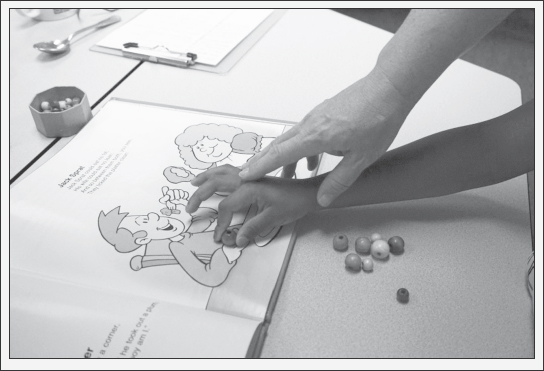
Child selects a bead to match the color of the man’s shirt.
Easier Activities:
• Enrichments 10, 12, 20 and their alternate activities.
• Put small pieces of different colored papers on the table and match beads to the pieces of paper.
Harder Activities:
• Draw simple shapes (circles, squares, and triangles) on small cardstock. One shape per card. Pick one of the shapes and look for that shape in picture books. Keep this simple at first by using books with shapes as the subject.
• Repeat the previous exercise with picture books showing objects with shapes you have been working with. For example, ask the child to find the circles in a picture of a bicycle.
Enrichment 32
Blow Foil or Feather
Activity: Blow aluminum foil or a small feather on the floor as far as possible
Goals: To integrate (oral) motor skills with visual skills. In addition, blowing activates facial and respiratory muscles which are used to display emotions and to regulate breathing.
Materials: Small pieces of aluminum foil or feathers.
Instructions: Place a small piece of aluminum foil on the floor. Have the child lie on the floor and blow the foil as far as possible. Once he gets the hang of this, place small targets on the floor and ask him to try to hit the targets.
Safety considerations: None.
Sensory considerations: None.
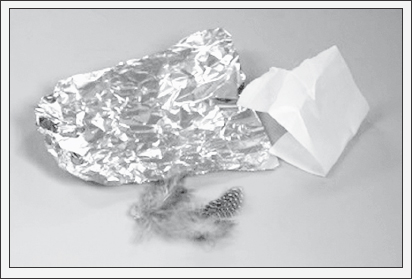
Foil, paper, a feather
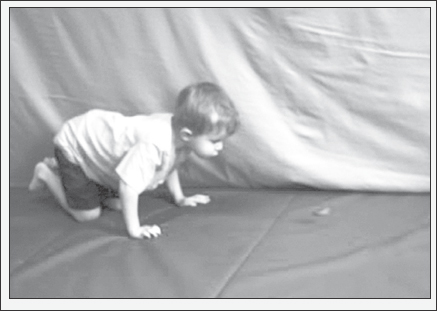
Boy is blowing a feather across the floor
Easier Activities:
• If the child does not yet know how to blow, try these procedures:
• Have the child observe you and imitate your mouth movement. Gently form his mouth into an O shape, and tell him to blow. Use a mirror for this activity.
• Blow bubbles with bubble soap as a way of increasing motivation. Put the soap in a bowl to make it easier. You blow first, then ask him to blow. Gently plug his nose to send air out of his mouth.
Harder Activities:
• Keep a balloon in the air using the breath only.
• See the additional exercises in Chapter 5 that make use of whistles and kazoos.
Enrichment 33
Visual Attention with Moving Pictures
Activity: View two pictures as they repeatedly move from back to front and back again
Goals: To increase attention to task; to help the child move between (and be aware of) different visual frames-of-reference.
Materials: Two or more pictures.
Instructions: With a photo in each hand, present the photos to the child, with one in front of the other. Talk about the picture, if only to say, “Here are two pictures, here is the first picture.” Then move the front picture to the back and the back one to the front, and say, “Here is the second picture.” With time, name elements in the pictures as they alternate moving into view, and also prompt the child to say something about each picture, “That’s grandma, that’s a cat.” Make a game of it.
Safety considerations: None.
Sensory considerations: None.
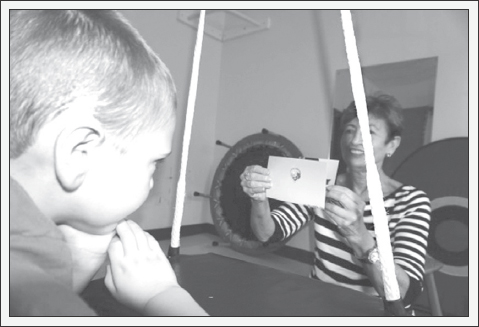
Boy attends to back-to-back pictures, telling his therapist what he sees in each picture as she brings one, then the other into view.
Easier Activities:
• Enrichments 13, 27 and their alternate activities.
• Enrichment 17 and its alternate activities.
Harder Activities:
• Ask the child to say what he sees each time the picture is swapped.
• Give the child a book with different images on each page, such as an alphabet book for small children or an age-appropriate picture book for older children. Tell the child that you are going to look at each page and say what you see. Go through 5-10 pages.
• Have the child turn the pages and name what he sees.
Enrichment 34
Pictures and Music
Activity: Listen to music that corresponds to a photo
Goals: To integrate hearing and vision; to integrate the senses with cognitive processing.
Materials: Songs and music albums with a theme such as ethnic music; photos in a book or on the internet that are associated with the music. Take the opportunity in this exercise to introduce the child to new sensory and cultural input, but also include child-friendly themes such as trains and theme parks and familiar activities such as brushing teeth.
Instructions: Play some music, and then show pictures that are related to the music. In a few words, describe the connection. For example, “This is music from Ireland. Here is a picture of the island of Ireland. Here is a picture of houses in Ireland,” and so on.
Safety considerations: None.
Sensory considerations: Allow the child to select (and to reject) some percentage of the music, but attempt to acclimate her to both music as a whole and to different styles of it.
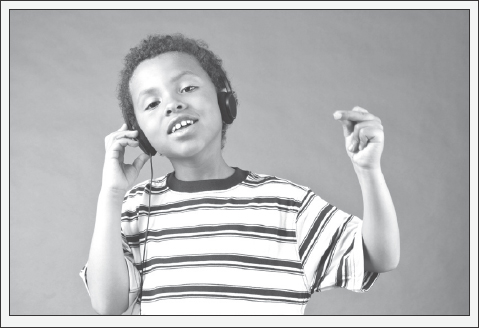
Have the child listen and move (dance) to music from around the world. Dancing will help with rhythm entrainment and help decrease undesirable behaviors associated with sound. Start slowly with music that is similar to what she currently likes. Avoid playing more than a minute or two of music that she finds annoying.

A picture of the island of Ireland

A picture of houses in Ireland